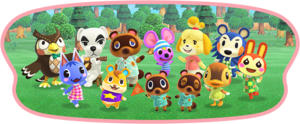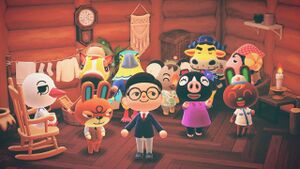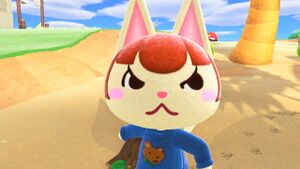Villager


Villagers, also known as animals or residents, are the main non-playable characters in the Animal Crossing series. They are the player's neighbors scattered around the player's town. They do most of the same things as the playable character, such as fishing, finding fossils, and collecting insects. Villagers, as suggested by the Animal Crossing series title, come in a variety of species.
Random villagers can move into the town at any time, usually after another villager moves out. Each villager initially comes with a unique interior house design, which will gradually change over time depending on what furniture they request, or insects, fish, fossils, and clothes they obtain. Flooring and wallpaper eventually change, usually depending on how long the villager has been a resident of the town. Unlike the player, they do not have the ability to expand their home.
Interaction[edit]
Villagers can be interacted with in various ways. The player can talk to villagers by approaching them and pressing the interact button. These conversations usually result in a line of relative dialogue, or the player receiving a request to complete. Requests uncommonly will trigger a game or small event. Interacting positively with villagers will develop the player's friendship with them.
Additionally, in Animal Crossing: New Horizons, villagers will frequently talk to the player about actions they did the previous day, such as burying Bells in shining soil, upcoming events, and more. They also generally have special dialogue for their first interaction with the player during the day.
Villagers will occasionally attempt to get the player's attention by eliciting a surprised Reaction and excitedly approaching the player (this is also known as a "ping" within the player community). Interacting with them in this state will produce special dialogue and requests or a notification of their imminent departure from town, giving the player an opportunity to prevent (or encourage) their move. In Animal Crossing: New Leaf, villagers in this excited state might request a new catchphrase or greeting, suggest an idea for a public works project, give or ask for an item, or could be thinking of moving out.
In addition, villagers can be annoyed in a number of ways:
- "Pushing" villagers by continuously walking into them for approximately eight seconds will result in them getting upset at the player.
- In Animal Crossing: City Folk onwards, a villager will become sad or angry after falling into a pitfall, whether the player talks to them whilst they are in the trap or not.
- Repeatedly talking to villagers to the point where they get annoyed. They may give warnings or yell at the player, and then refuse to talk for a while, or in Animal Crossing: New Leaf onwards, say that they are "thinking" and cannot talk at the moment.
- Hitting villagers with certain tools (such as the Net, the Toy Hammer, or the Axe[nb 1]) three times in a row will result in them becoming upset.
- In Animal Crossing: New Leaf, using the Megaphone too close to a villager may startle them and consequently result in them complaining.
- In some games, refusing favors can upset villagers. In Animal Crossing: City Folk, for example, declining a task (such as a delivery, hide-and-seek, or greeting change) will usually result in the villager becoming sad.

Personalities[edit]
|
Male |
Female |
There are different personalities and characteristics found in villagers. Hobbies, style, and color preference are not unique to each personality, but some are more apparent in individual personalities than others. There are eight different personalities: lazy, jock, cranky, and smug, which are male villager personalities, and normal, peppy, snooty, and big sister, which are female personalities. The smug and big sister personalities were introduced in Animal Crossing: New Leaf, while the rest were introduced in Doubutsu no Mori.
Internally in Animal Crossing: Pocket Camp, the male personalities are ordered from B1 to B4 (lazy, jock, cranky, and smug), and the female personalities are ordered from G1 to G4 (normal, peppy, snooty, and big sister). B1 to B4 likely stands for boy 1 to boy 4, while G1 to G4 likely stands for girl 1 to girl 4. Internally in Animal Crossing: New Horizons, a unique ID from 0 to 7 is associated with each personality type, giving a default sort order of lazy, jock, cranky, smug, normal, peppy, snooty, and big sister.
Certain personalities for one gender are counterparts to certain personalities of another gender. For example, lazy and normal villagers are calm and average but are very kind and easily able to make fast friends with. Internally in Animal Crossing: New Horizons, they are respectively labeled as boy_normal and girl_normal, and they are sorted as the first personality for their respective genders.
Jock and peppy villagers are energetic, cheerful, and slightly overbearing, but are very enthusiastic and mean well. Internally, they are respectively labeled as boy_active and girl_active, and they are sorted as the second personality for their respective genders.
Cranky and snooty villagers are arrogant and rude, but they can be very experienced and caring when the player gets to know them. Internally, they are respectively labeled as boy_pride and girl_pride, and they are sorted as the third personality for their respective genders.
Smug villagers act egotistical and sophisticated, while big sister villagers are tomboyish and laid-back. Internally, they are respectively labeled as boy_snobby and girl_big_sis. Although they are not as similar from a personality perspective, they were both introduced in Animal Crossing: New Leaf, so they are both internally sorted as the fourth personality of their respective genders.
Villagers of the same personality tend to have very similar dialogue, apart from their catchphrase. However, in Animal Crossing: New Horizons, each personality has two subtypes (mostly correlated with one or two common hobbies per subtype) which have distinctive dialogue that can be encountered occasionally once the player reaches a high level of friendship with the villager.
Villager ID[edit]
Nearly every character in the Animal Crossing series has an assigned "ID" which is used internally by the games to identify them. These consist of a three-letter species prefix followed by a number for villagers, or a simple three-letter abbreviation for special characters. Full lists of these IDs can be found here:
- List of villager IDs (Animal Crossing) – List of IDs given to villagers in the system used by the first generation of games on the Nintendo 64 and GameCube (Doubutsu no Mori, Doubutsu no Mori+, Animal Crossing, and Doubutsu no Mori e+).
- List of villager IDs – List of IDs given to villagers in the system every game in the series from Wild World onward has used. Although some are currently unknown, this system has an ID for every villager with the exception of the Doubutsu no Mori e+ promotional villagers: Nindori, Pierre, Bow, Meow, Shoukichi, and Shinabiru.
- List of special character IDs – List of IDs given to special characters that can vary between games.
The species prefixes for villagers are as follows:
crdAlligator [nb 2]antAnteaterbeaBearbrdBirdbulBullcatCatcbrBear cub [nb 3]chnChickencowCowderDeerdogDogdukDuckpbrEagle [nb 4]elpElephantflgFrog [nb 5]goaGoatgorGorillahamHamsterhipHippohrsHorsekalKoalakgrKangaroolonLionmnkMonkeymusMouseocpOctopus [nb 6]ostOstrichpgnPenguinpigPigrbtRabbitrhnRhinocerosshpSheepsquSquirreltigTigerwolWolf
Similarly, each villager personality is assigned a two-character ID, derived from their Japanese name. They are as follows:
|
Male |
Female
|
Appearances[edit]
In Animal Crossing[edit]
Initially in Animal Crossing, there are six villagers in the town when the player moves in. The maximum number is 15; once 15 villagers have moved in, one of the already existing villagers will move out without warning to allow a new villager to move in. Villagers have a unique role in Animal Crossing. During town events, they gather and celebrate in different areas of the town to partake in different events. Most noted is during the New Year's Eve celebrations, where they gather around the town pond (in future releases except in New Horizons, they are simply scattered around town, and have special conversations revolving around the festivities).
During summer and winter, villagers may live outside in a tent or an igloo for the day, where they become the source of collecting special furniture items. In future game releases, they are not a source of rare, unique furniture, but become a means of gaining furniture through trades. They also do not camp out, and only live in their homes.
In Wild World[edit]
Initially in Animal Crossing: Wild World, there are three villagers in the town when the player moves in out of a possible eight. Once eight villagers have moved in, one of the already existing villagers may move out to allow another new villager to move in, lowering the number to seven until the new villager moves in. Although villagers do have a similar role as they do in Animal Crossing, they also have a few new features.
When the playable character befriends them, they are likely to give the player a picture of themselves as proof of their friendship. Each picture has a unique quote for each villager, which can be read when the picture is placed in the player's house and interacted with.
They are also competitive in Wild World, a feature unique to the game. During some conversations, they may ask the player if they want to see who can catch the biggest fish or find the rarest insect. These are games which are similar to the Fishing Tourney and Bug-Off. During these events, when two villagers meet they will not talk.
Another new feature were the rumors that some villagers were dating. This could be discovered by talking to some of the villagers in the town who would either be gossiping about the two villagers or one of the two villagers in the relationship. There was no proof of the two villagers dating, however, other than through conversation.
Unlike the first game, the villagers walk at a much slower pace than the player, which is continued through Animal Crossing: City Folk.
For the first time in the Animal Crossing series, a new villager species was introduced in Animal Crossing: Wild World: monkeys. (Although Porter is also a monkey and was in the games between Doubutsu no Mori and Doubutsu no Mori e+, he is a special character.)
In City Folk[edit]
Initially in Animal Crossing: City Folk, there are six villagers in the town when the player moves in. The maximum number is ten. Once ten villagers have moved in, one of the already existing villagers will attempt to move out to allow a new villager to move in.
Villagers have a slightly different role than in Animal Crossing: Wild World. They no longer compete against the player, as this feature was prominent enough in Bug-Off and Fishing Tourney events. They do, however, have a new feature: playing hide-and-seek, where a group of up to three villagers hide around the town. They no longer give out pictures of themselves when they become friends with the player.
Villagers now talk about the glamour and style found within the city, a new area found in the game.
In New Leaf[edit]
Initially in Animal Crossing: New Leaf, there are five villagers in the town when the player moves in. The maximum number is ten, although the tenth villager will not move in unless the player invites them to move in, either through the campground (as of Animal Crossing: New Leaf - Welcome amiibo) or campsite, or if they communicate with a player whose town had any villagers move out.
Villagers now have more actions than in previous games. For example, they will shake trees, plant flowers, be seen entering and exiting stores, and will fish during the Fishing Tourney. Players can sometimes find lost items on the ground and return them to their rightful villager owners. Villagers will give the player pictures of themselves again, albeit in uncommon circumstances. Also, villagers have more expansive opinions about the player's reputation. Non-resident villagers of the player's town will be able to appear in the campsite where they can be interacted with for special dialogue and convinced to move in. They also may appear in the café in place of resident villagers. Villagers who move out of town eventually appear regularly on Main Street.
Two new villager species, the deer and the hamsters, were introduced in New Leaf.
For the first time in the series, two new personalities are introduced, one new one for each gender. For male villagers, the new personality is smug キザタイプ (Kiza Type). For female villagers, the new personality is big sister アネキタイプ (Aneki Type).
In Happy Home Designer[edit]
In Animal Crossing: Happy Home Designer, villagers appear as clients, and the player designs a house for them to move in to. When visiting a house, villagers can be seen exercising, cleaning, or singing. The player can also invite villagers to the designed house. Villagers can also be seen in buildings, like the school and shops.
In New Horizons[edit]
As of version 2.0, Animal Crossing: New Horizons features 413 villagers, including all the villagers in Series 1-4 of Animal Crossing amiibo cards (333 characters), the 50 villagers of the Welcome amiibo series of amiibo cards, the 6 Sanrio villagers, 3 returning from Doubutsu no Mori, 1 returning from Animal Crossing, 4 returning from Doubutsu no Mori e+, and 16 new villagers to the series.
The player arrives at the deserted island with two other villagers, the fewest starting villagers of any game in the series. These villagers are always one jock villager and one big sister villager, out of a total of 83 possible starting villagers. Three additional villagers can move in after meeting certain criteria, one at a time. Those villagers are a lazy villager, a peppy villager, and a normal villager. Then up to five more (at least one of which will be smug), for a maximum of ten, can be moved in either via the campsite, which can be built once the Resident Services center is upgraded from a tent into a building, through further Mystery Island Tours, or by inviting them from another player's town.
Villagers have even more interactivity and actions than in New Leaf. They can sometimes be seen in their homes, working on a DIY recipe, and they will share it with the player when talked to, even if the player already has that particular recipe. The 2.0 Free Update also made it possible to have villagers invite the player to their house, ask the player for an invitation to the latter's house, or enter the player's house for a random visit. Villagers can make comments about furniture when the player interacts with it, play a minigame with the player ("High Card, Low Card"), and offer them gifts as a thank you for their visit.
Villagers can be seen attempting to catch bugs, along with the fishing they did in New Leaf. They may also perform a variety of other actions such as eating and drinking, sprinting, exercising (including stretches, yoga, and lifting dumbbells), reading books, examining objects with a magnifying glass, or singing to themselves. If music is playing on a nearby music player, villagers may even sing along to the song. While many of these activities can be performed by any villager, each villager has a primary hobby distinct from their personality, which leads to certain preferred activities. If a player is visiting the host player's island, all of the villager's actions will be limited to walking to a designated area, idling, and repeating. However, villagers working on DIY recipes, villagers moving in or out, and villagers celebrating another villager's birthday will continue to do so. Additionally, it is not possible for the visiting player to enter a villager's house if they are sick.
New to this game, after the player has annoyed a villager, they can apologize to them if talked to enough times while angry or sad, in which doing so results in the villager easily forgiving them.
See also[edit]
Notes[edit]
| Gameplay elements | ||||||||||||||||||||||||||
|---|---|---|---|---|---|---|---|---|---|---|---|---|---|---|---|---|---|---|---|---|---|---|---|---|---|---|
| ||||||||||||||||||||||||||
| Species | ||||||||||||
|---|---|---|---|---|---|---|---|---|---|---|---|---|
| ||||||||||||
| Villager personalities | ||||||||||||
|---|---|---|---|---|---|---|---|---|---|---|---|---|
| ||||||||||||
